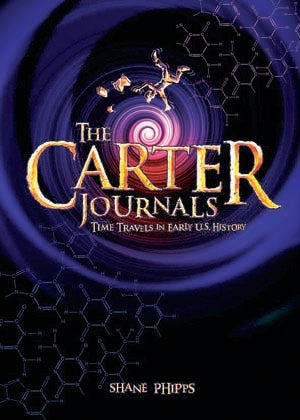The Carter Journals: Teacher writes book to inspire students
Published 9:33 am Monday, January 18, 2016

Contributed Photo
“The Carter Journals” by Shane Phipps tells the story of young Cody Carter as he learns his family’s place in history by reading a set of journals that transport him back in time. Among Cody’s ancestors are local historic figures John and Landon Carter and Cody gets to experience life as Landon Carter during the siege of Fort Watauga.
When Indiana history teacher Shane Phipps began looking for material to use in his class he couldn’t find just the right book to use, so he decided to write his own. And, it just so happens, his students will be learning a bit about Carter County and some of its early residents when they crack open Phipps’ book The Carter Journals.
“I have taught 8th grade US History for 15 years,” Phipps said. “I learned, early on, that the best way to engage students was to build my library of stories that I could tell them that made history come to life more for them.”
To expand his repertoire, Phipps began reading… a lot. He discovered historical fiction works by authors like Allan Eckert and James Alexander Thom, but they didn’t seem to fit with his classroom needs.
“I started longing to find a good historical fiction that I could have my students read in class. The problem was, most all of the historical fictions geared towards young adults are centered around one particular event,” Phipps said. “The problem with that is it is difficult to devote the amount of class time to reading such a book without falling behind in the standards we are supposed to cover.”
“I wanted a book that I could use all year. One that bounced along the historical timeline along with the textbook,” he added. “Since one didn’t exist — that I was aware of anyway — I decided to write it myself.”
And thus, The Carter Journals was born. Phipps describes the book, his first published novel, as “seven short stories, or journals, woven together into one novel.
To tie everything together, Phipps created the character of Cody Carter, who gets the amazing opportunity to experience history through the eyes of his ancestors. And, Phipps admits, Cody is a bit of a self-portrait loosely based on the author.
“To keep a central character as a protagonist, I decided on the time-travel device as a way to bounce in and out of different eras,” Phipps said. “I have gotten a lot of good feedback from students and teachers who enjoy this luxury of being able to read the book a little at a time throughout the year, although it can just as easily be read all at once too.”
Phipps picked the family name “Carter” before he finished his research and was pleased when it worked in his favor.
“The Carter family is mostly fictional. It was a happy accident that I discovered in my research, only after I had begun writing the book, that there were Carters who played a significant role in the history of the Ft. Watauga and State of Franklin story,” Phipps said. “When I found that, I went ahead and ran with it.”
“So Landon Carter is actually the only one in the book who is based on a real Carter,” he added. “The rest are just fictional characters I plug into historical events.”
In the book, young Cody Carter receives a box of journals from his grandfather when he comes of age. His grandfather tells him that keeping a journal is a rite of passage for the Carter family, as is reading the journals of the Carters who came before.
When Cody opens the pages of the first journal, he feels himself being pulled through time. The magic of the journals allows him to experience history through the eyes of his very own ancestors, making history all the more real and personal to him.
Through the journals, Cody gets to go hunting with Daniel Boone on a trip to Blowing Rock through the Yadkin River Valley. He gets to witness the signing of the Transylvania Purchase at Sycamore Shoals and later survives the siege of Fort Watauga, watching first hand as John Sevier pulls Bonnie Kate Sherrill over the palisade of the fort to rescue her from an attacking band of Cherokee. He learns about the Lost State of Franklin. Cody hides runaway slaves on a canal boat as part of the Underground Railroad and fights in the Battle of Corydon in Indiana during the Civil War.
The journals take Cody on a journey not only through time, but across a large stretch of the country as well. The first journal transports Cody to coastal North Carolina and through westward expansion, he finds himself moving through the country before ending up in Indiana.
In the first journal, Cody’s ancestor, Edward Carter Jr., who it just so happens, had an encounter with the notorious pirate Edward Teach, better known as Blackbeard.
“I have vacationed many times in the Outer Banks of North Carolina and I love the little seaside village of Beaufort. When I was outlining the story of the book, I wanted it to start there, since I was so familiar with it,” Phipps said. “I used Blackbeard — whose ship ran aground near Beaufort — as one of the stories in that journal along with the Tuscarora Indian Wars.”
Phipps has travelled through North Carolina, and knowing that Daniel Boone had settled in the Yadkin Valley for a time, decided to include Boone in that part of the story.
“That was a perfect place to work him into the story for the first time…before he was the famous frontiersman,” Phipps said. “I also knew and loved the area around Blowing Rock, so I have Boone and Cody go on a hunting trip into the Blue Ridge where they scale the Blowing Rock and Boone tells his version of the Indian fable that is attached to that place.”
Phipps is also no stranger to Northeast Tennessee and Carter County.
“I am very familiar with Fort Watauga and Sycamore Shoals,” he said. “I spent much of my childhood wandering that area with my grandfather.”
“My dad was born and raised in Goshen Valley, near Church Hill in Hawkins County,” Phipps added. “My grandpa would take me around to all the historic areas like Jonesborough, Sycamore Shoals, Rocky Mount, etc.”
Those excursions with his grandfather left a lasting impression on Phipps.
“I was fascinated by the history of the region and was proud that my family roots run so deep there. That is why I say Cody is based loosely on me,” Phipps said. “His grandfather, the one who gives him the journals to read written by his ancestors, was also from Hawkins County.”
“Two of the seven journals in the book take place in and around Fort Watauga,” he added. “East Tennessee plays a major role in the book, just as it has in my life.”
While Phipps wrote the book as a way to help teach his class, he has other goals for the book as well.
“I hope it sparks and interest in history. I really hope it helps people who have not done so to seek out their family’s place in the story of America,” Phipps said. “We are all a part of the story. It is not HIS-Story it is Our-Story, I like to say.”
“When people find their connection to history, they are hooked for life,” he added. “That is the connection that Cody finds in The Carter Journals.”
The Carter Journals is the first book to be published by Phipps, but not his first, or his last, writing effort.
“I have long enjoyed creative writing but never pursued it for mass publication,” he said. “I mostly wrote short pieces for the amusement of my friends.”
He also has a blog that can be found at shanephipps.wordpress.com.
“I do have plans to write more books,” Phipps said. “I have a couple ideas that I am developing now, both of which are young adult focused historical fictions.”
“There may be a sequel to The Carter Journals as well,” he added.
The Carter Journals was published by the Indiana Historical Society and is available for purchase online at www.indianahistory.org and is also available in both book and e-reader format online through Amazon, Books-A-Million and Barnes & Noble.



